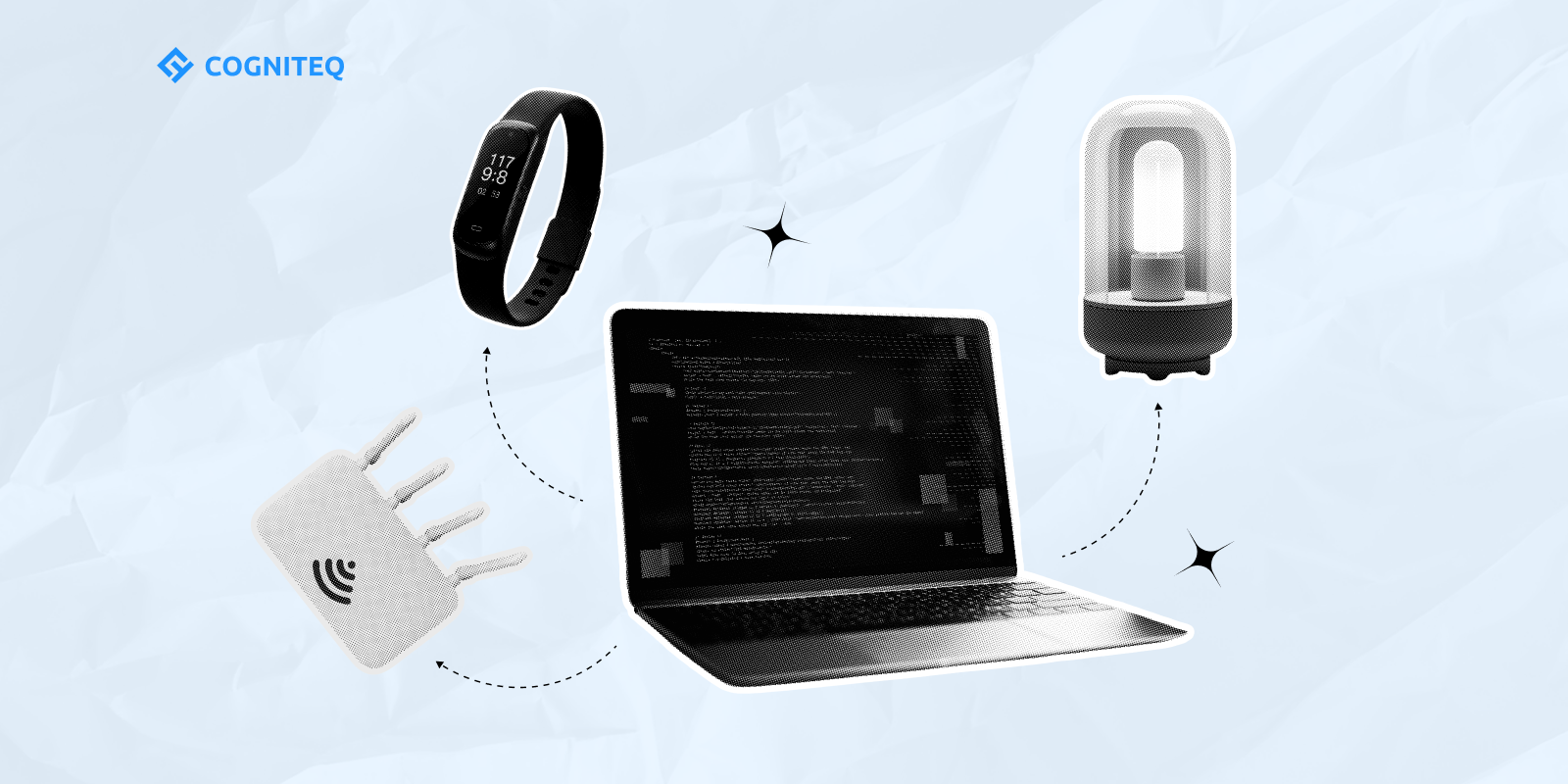Selecting the right tech stack is one of the most important decisions in any IoT project. Specifically, the technologies behind an IoT system directly impact its performance, scalability, security, and maintainability. The integration of diverse IoT devices into a reliable application can be challenging due to protocol differences and data formats. That’s when Node.js enters the game.
In this article, we are going to talk about the role and value of Node.js in IoT. We will also share the most common challenges of integrating smart devices, as well as practical tips on how to increase the security of such systems based on our practical experience in IoT development.
What is Node.js?
Node.js is an open-source, cross-platform JavaScript runtime environment. With its help, developers can run JavaScript code outside of a web browser. It is built on Google Chrome’s V8 JavaScript engine and uses an event-driven, non-blocking I/O model.
According to Statista, in 2024, Node.js was the most popularly applied web technology, with over 40% of surveyed developers using it for their projects.
Node.js is designed to handle a large number of simultaneous connections. Given this, it’s widely used for real-time applications, APIs, and also IoT solutions. Thanks to numerous libraries available through its Node Package Manager (npm), this technology enables developers to build software products fast and rely on reusable modules.
Today, Node.js is gaining popularity in the sphere of the Internet of Things.
Have an idea for an IoT project?
At Cogniteq, we will help you transform it into a fully functioning product that will bring real value to your business and your clients.
Benefits of Node.js in IoT development
There are several notable advantages that you can leverage by choosing Node.js for IoT development. Let’s consider the most significant of them.
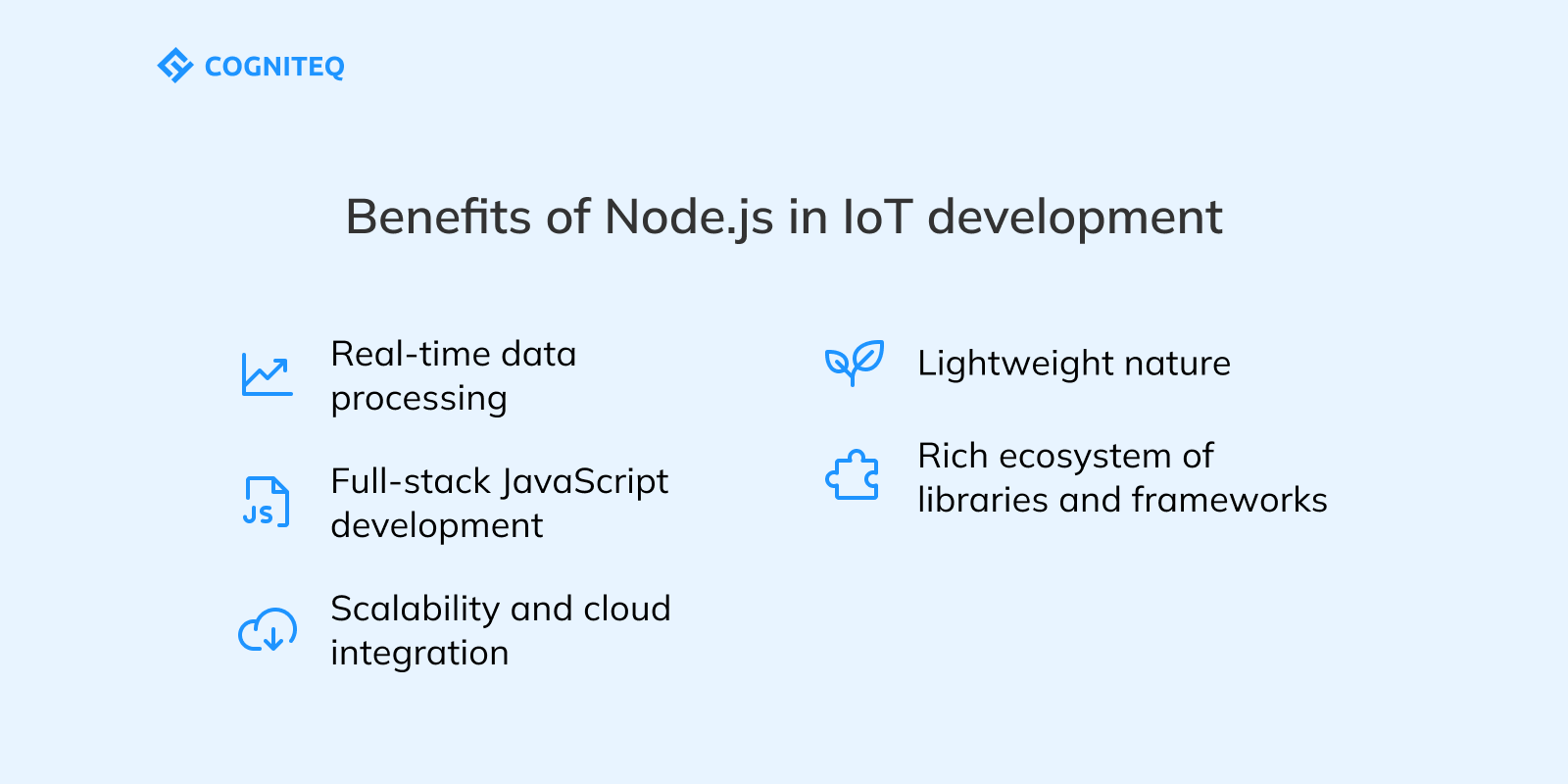
- Real-time data processing
What is important about IoT systems is the fact that quite often they need to process data from thousands of devices at the same time. Node.js can efficiently cope with this task. This JavaScript runtime environment is powered by an event-driven, non-blocking architecture. As a result, Node js solutions can handle large numbers of concurrent connections with minimal latency.
- Lightweight nature
Today, many IoT devices and gateways have limited processing power. That’s why it is crucial to opt for technologies that don’t need to consume a lot of resources for their functioning. Node.js is lightweight. Its nature allows it to run efficiently even on low-resource hardware. That’s why it is suitable for embedded systems and edge computing scenarios.
- Rich ecosystem of libraries and frameworks
The Node.js ecosystem offers a lot of tools that significantly facilitate and speed up the development process. With their help, developers can avoid building various components from scratch. For instance, MQTT.js is applied for device communication, Johnny-Five is used for hardware interaction, and Node-RED is a suitable option for rapid prototyping.
- Full-stack JavaScript development
When you choose Node.js for IoT development, JavaScript is applied on both the server and client sides. This approach simplifies the process of creating IoT applications. Teams can share code and reuse built components. This helps to maintain consistency across the entire stack, which reduces the development time and lowers maintenance costs.
- Scalability and cloud integration
Another important benefit is the seamless integration of Node.js with cloud platforms and its support for microservices. This makes it easy to build scalable IoT solutions that will grow together with your needs.
Integration of IoT devices: Key challenges
One of the most challenging parts of any IoT development project is the correct and reliable integration of all devices into a single, smoothly functioning system.
Based on the practical experience of our team in creating IoT solutions of different types, we can define the most common pitfalls that you can face while integrating IoT devices.
- Fragmentation of devices and protocols
Modern IoT devices are often powered by different hardware platforms, operating systems, and communication protocols. This situation makes the task of ensuring interoperability between such systems pretty complex and time-consuming. Developers should have solid expertise and deep theoretical knowledge to make diverse devices smoothly interact and exchange data.
- Security and data privacy
Each device connected to the internet can easily act as a potential entry point for cyberattacks. As hackers’ approaches are continuously becoming more sophisticated, proper protection measures are a must. Strong authentication, encryption, and secure data storage are essential. Nevertheless, it can be difficult to standardize them across devices of different types.
- Scalability
When your IoT system grows, the infrastructure should be ready to deal with increasing data volumes and simultaneous device connections. Moreover, all this should be possible without the system performance degradation. If your system was designed without scalability in mind, it can struggle to expand effectively.
- Data management
The Internet of Things solutions generate vast amounts of data. This data needs to be collected, processed, and transferred to analytics platforms in real time. When integrating IoT devices, developers should ensure the accuracy of data transmission and processing, its consistency, as well as the possibility of generating meaningful insights without delays.
- Power and connectivity limitations
Many IoT devices run on batteries and/or are located in remote areas with limited connectivity. Given this, it is also essential to think about the energy efficiency of solutions and their resilience to network interruptions. Otherwise, it won’t be possible to achieve the desired reliability of your IoT system.
Is it secure to use Node.js in IoT development?
Node.js can become a secure foundation for your IoT system. However, its safety will always depend on how well it is implemented and maintained.
Node.js supports modern security standards, like TLS/SSL encryption, secure APIs, and authentication protocols. Apart from this, it also has an extensive ecosystem of libraries for building secure communication channels and managing identity.
Nevertheless, without a relevant approach to IoT device integration, it is impossible to ensure the desired level of safety and data protection.
How to maximize security when using Node.js in IoT development
- Encrypt all communications between devices;
- Authenticate and authorize devices with API keys, OAuth, or JWT;
- Validate and sanitize inputs to prevent such vulnerabilities as injection attacks;
- Regularly update dependencies;
- Use monitoring and anomaly detection tools to respond quickly to threats.
How to use Node.js to integrate IoT devices: Step-by-step guide
Based on our solid experience in IoT development, we’d like to share a practical guide on how to integrate smart devices into a comprehensive network with the help of Node.js.
Step 1. Choose the right protocols
You need to choose the communication protocols that fit your use case the most. You should consider such factors as power consumption, latency, and security.
For example, you can opt for:
- MQTT for lightweight, low-power messaging;
- HTTP/HTTPS for simple RESTful APIs;
- WebSockets for real-time bidirectional updates.
Step 2. Set up a Node.js IoT project
Then, it is required to install Node.js and initialize it. We recommend you add key libraries like mqtt, socket.io, express, or cloud SDKs (AWS IoT, Azure IoT).
At this stage, it is necessary to implement basic security, including TLS/SSL, authentication tokens, and API keys.
Step 3. Connect devices and collect data
Now, you need to configure IoT devices with credentials and proper protocol settings. You can use Node.js services to subscribe to device messages and receive sensor data.
Incoming data should be validated and stored securely (you can use reliable databases like MongoDB, PostgreSQL, or cloud storage).
Step 4. Integrate your system with cloud and third-party services
Your IoT application should be connected to the chosen cloud IoT platform, such as AWS IoT Core, Google Cloud IoT, or Azure IoT Hub.
It is essential to enable device management and remote configurations.
To share data with external systems, like ERP or CRM software, you can use APIs.
Step 5. Build real-time dashboards
To create live dashboards, it is possible to use Node.js with front-end frameworks (React or Vue) or monitoring tools (for example, Grafana).
In addition to this, you can introduce an alert system with SMS, email, and push notifications for critical events.
Step 6. Scale and secure your IoT system
For proper protection of your system, you need to encrypt all communication between devices and servers, as well as regularly audit your code.
The modern IoT development principles also include containerization and orchestration. While containerization tools like Docker allow developers to package and deploy IoT services consistently across environments, orchestration platforms like Kubernetes help manage containers and ensure high availability.
Real-life Node.js use cases
Today, Node.js is used in many IoT solutions of different types, including but not limited to:
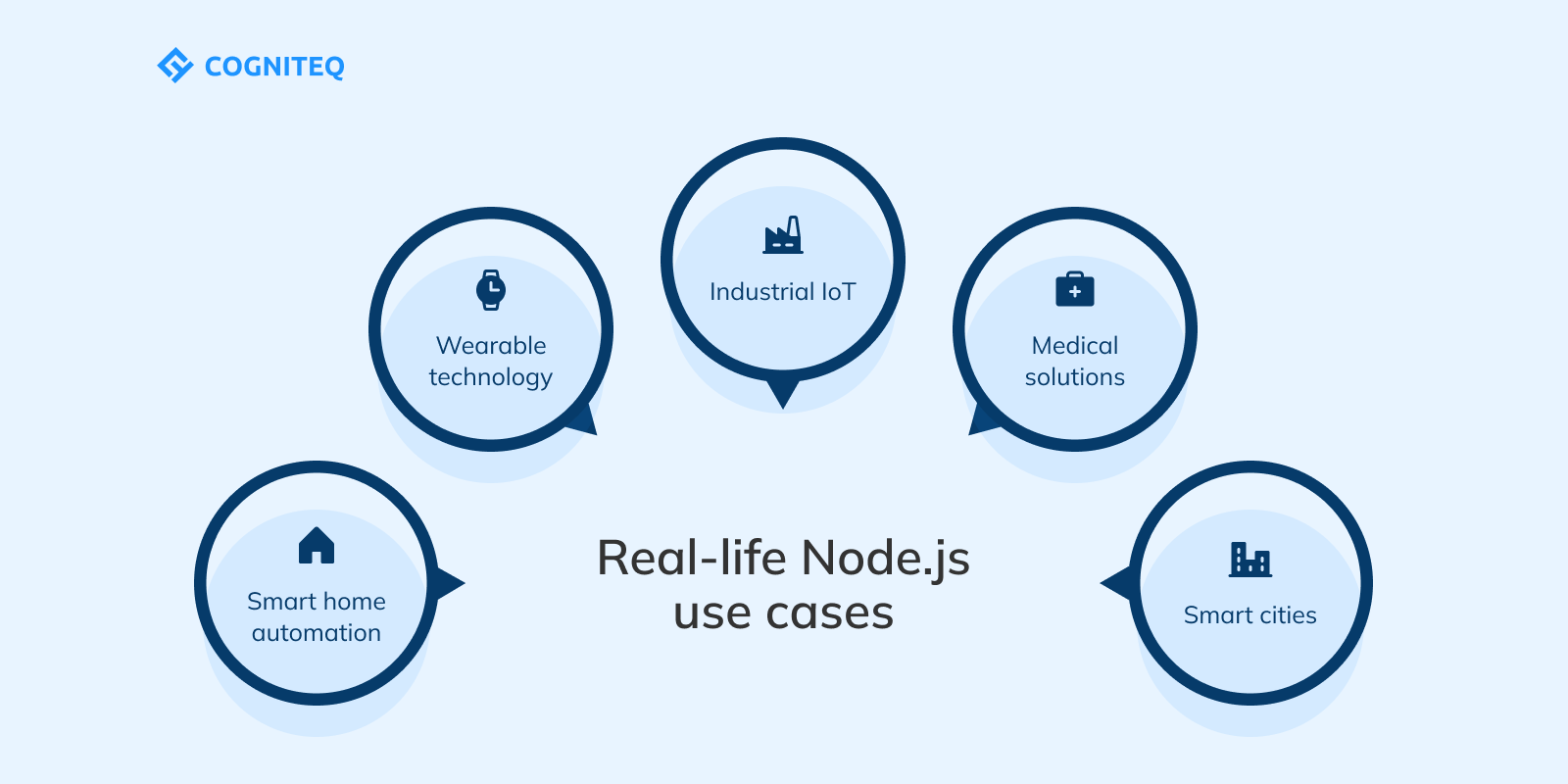
- Smart home automation. With its real-time data handling and easy device integration, Node.js often powers smart home apps that let users remotely control their appliances, lighting, and security.
- Wearable technology. Many fitness trackers and smartwatches rely on Node.js to process and transmit sensor data to the cloud. This enables them to deliver personalized health insights and track activity goals.
- Industrial IoT. Industrial enterprises implement Node js solutions to monitor energy use and detect anomalies. In factories, IoT systems help track equipment performance, predict maintenance, and optimize workflows.
- Medical solutions. Node.js supports remote patient monitoring. IoT devices can collect real-time health metrics, medication data, and vital signs, and simultaneously transmit them to providers for proactive care and timely interventions.
- Smart cities. Local authorities and public utilities leverage Node.js for IoT systems that manage traffic, optimize public transport, and reduce energy use in public infrastructure.
In our practice, there was also a range of IoT projects powered by Node.js.
One of them is the IoT-based smart parking app. Our client turned to us with a request to build a mobile solution that would help drivers find and book paid public parking spaces. Before contacting us, this US startup already had an application, but it was outdated and didn’t satisfy the needs of potential users. The solution was inconvenient and lacked real-time parking space availability updates.
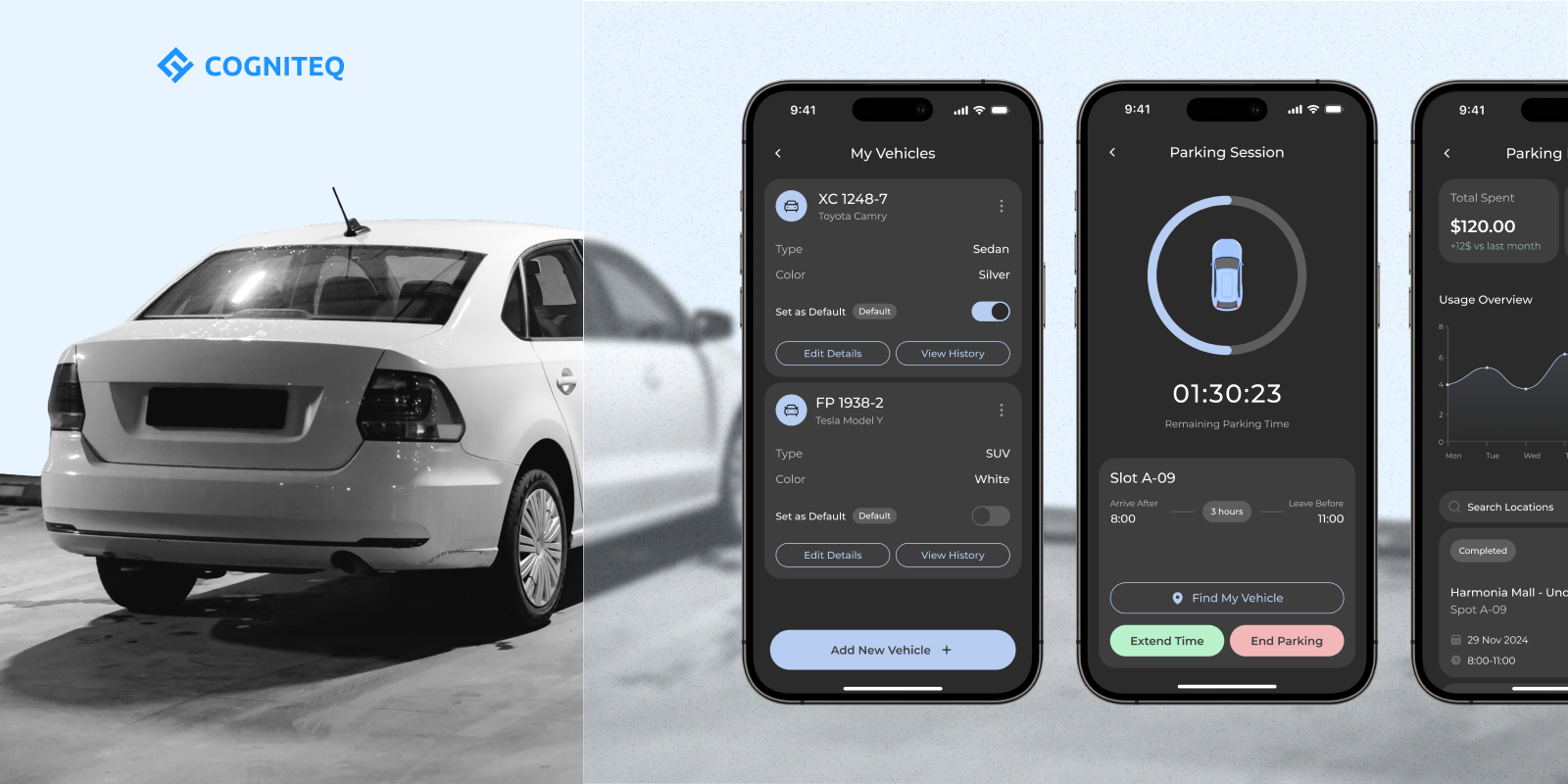
We needed to analyze the existing product and find the most efficient approach to make it competitive and valuable for users. Instead of modernizing the provided software, we decided to develop new apps for iOS and Android devices. We carefully analyzed the desired functionality of new apps and chose the most suitable tech stack for it. Node.js was one of the technologies that was used to ensure smooth handling of large volumes of data in real-time.
The most important change introduced to the solution was the replacement of manual parking availability tracking with real-time sensor data. This feature helps optimize capacity and improve overall space usage.
Another example of using Node.js in IoT projects is the development of the IoT middleware platform. Our team cooperated with an IoT device retailer. The client provides IoT, LoRaWAN, and cellular LPWAN solutions using low-power, battery-operated sensors. These sensors send small data packets (like temperature or humidity) via NB-IoT or LTE-M networks. Data transfer methods often vary by manufacturer. As a result, integrating different devices requires multiple protocols. To address this issue, we needed to create a web app that was expected to act as a middleware platform for accumulating and unifying data from different devices.
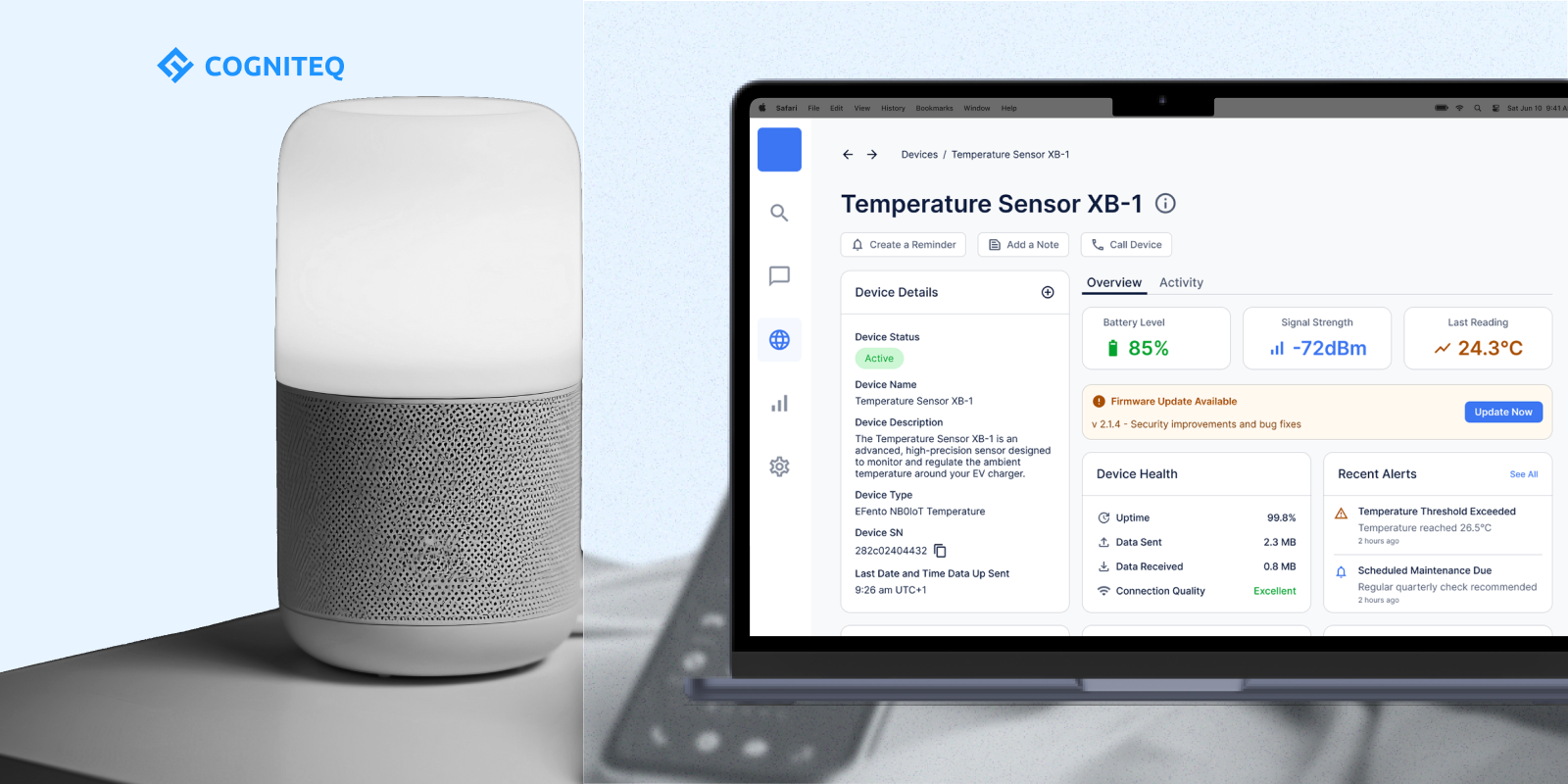
We managed to build a solution that enhanced data integration and system reliability, which allowed our client to expand its global reach.
Wrapping up
The use of Node.js for IoT device integration can be a successful choice. Nevertheless, for efficiently solving this task, it’s not enough just to connect sensors. In addition to this, it is also necessary to select the right protocols, ensure secure communication, as well as provide favorable conditions for scalability.
If you need a reliable partner that can cope with IoT development tasks of any complexity, at Cogniteq, we are always ready to support you. Our experts will attentively study your needs and find the most appropriate approach to address them. Contact us to discuss our possible cooperation!
FAQ
Is Node.js a suitable choice for IoT development?
Yes, Node.js is widely used for IoT. It is lightweight, event-driven, and can handle many concurrent connections. It is known for its non-blocking I/O model. All this makes it suitable for processing real-time data from numerous IoT devices with minimal resource usage.
How can Node.js work with IoT data at scale?
Node.js relies on microservices, cloud platforms, and message brokers like Kafka or RabbitMQ to handle IoT data at scale. It processes streaming data asynchronously and can integrate with databases and distributed systems to work with high volumes of sensor data.
What protocols are supported for IoT integration with Node.js?
Node.js supports such IoT protocols as MQTT, CoAP, HTTP/HTTPS, and WebSockets. They ensure efficient interaction between devices, gateways, and cloud services.
What libraries or frameworks are usually used for IoT with Node.js?
The list of commonly chosen libraries includes MQTT.js for MQTT communication, Johnny-Five for hardware programming, and CoAP libraries like node-coap. As for frameworks and development tools used for building IoT solutions, the most popular options are Node-RED and Cylon.js.
